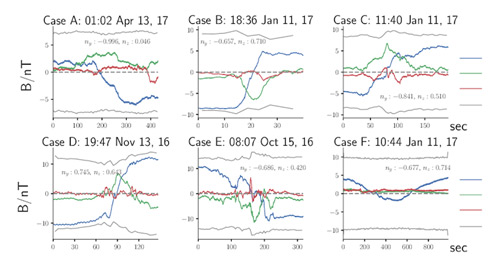2018 ARTEMIS SCIENCE NUGGETS
Intense field aligned current in current sheets at lunar distance
by Steven Sixue Xu
UCLA EPSS
Introduction
The continuous solar wind stream deforms the dipole magnetic field of the Earth, forming a region known as the magnetotail. It extends into space far beyond the Moon’s orbit, which is 60 Earth radii (RE) away from the Earth. The magnetotail confines a hot plasma layer, the plasma sheet, whose magnetic field component switches direction at the magnetic equator. It was established that this change in the field direction occurs in a thin layer called the magnetotail current sheet. The current sheet is a key region in the magnetosphere, because an instability within it can result in an explosive release of magnetic energy, the process that causes magnetic storms. Although many missions have explored the current sheets within 30RE, their properties at 60RE are poorly understood due to the scarcity of data. In this work, we studied the structure of the magnetotail current sheet at lunar distances by probing it with two lunar-orbiting satellites, Acceleration, Reconnection, Turbulence and Electrodynamics of Moon’s Interaction with the Sun (ARTEMIS). We found that the structure of the current sheet at lunar distances significantly differs from that in the near-Earth magnetotail. This is important information that allows us to better understand the magnetotail current sheet stability in this unique environment.
| Figure 1. Observation of multiple current sheet crossings by ARTEMIS P2 on Nov 13, 2016. From top to bottom: 1)magnetic field vectors in GSM coordinate, 2) density, 3) thermal and magnetic pressures. |
Observations
Figure 1 shows a typical current sheet crossing observed by ARTEMIS P2 on November 13 2016. Three panels show the magnetic field in GSM coordinate system, density variation and thermal/magnetic pressure during a 20 minute period. During this time interval, the Bx component flips from positive to negative and back several times, which indicates the current sheet is moving up and down across the satellite. This flapping motion enables us to study the inner structure of the current sheet. The inverse correlation between thermal and magnetic pressure in the third panel is evidence of total pressure balance across the current sheet. Although the current cannot be measured directly due to the limitation of particle measurements, if one can reasonably estimate the thickness of the current sheet, the current density can be inferred from Ampere’s Law.
| Figure 2. Magnetic field in 5 force free current sheet and 1 typical current sheet crossing. Field components are plotted in the local coordinate system. In the first 5 cases, a bell shape Bm, perpendicular to the normal and field reversal direction, is observed. It not only contributes to the total pressure balance, but also indicates a strong parallel current. Further study shows the parallel current density ranges from 1-10 nA/m2. |
Similar cases were visually selected from two ARTEMIS probe measurements from June 2016 to June 2017; we identified 130 events in total and studied their properties. Statistical studies of these current sheet observations reveal a previously unknown property of this magnetotail region: in about half the 130 events examined, the current sheet contains a strong dawn-to-dusk magnetic field component, peaking at the current sheet center (some of them are shown in Fig 2). Because this component is a sizeable fraction of the lobe field, it contributes significantly to pressure balance. In these events, therefore, the cross-tail current, also typically in the dawn-to-dusk direction, is largely field aligned. They also appear to be more common when density and thermal pressure is low and favorable for force free configuration, as shown in Fig 3.
| Figure 3. Distribution of central current sheet density and thermal pressure versus Bm contribution in the total pressure balance. Almost half of the current sheets observed carry significant Bm component. Few cases are found in the upper right panel, suggesting that current sheet Bm tends to be strong when thermal pressure is low. |
Conclusions
The observations of unexpectedly strong field-aligned currents at lunar distances open important issues regarding magnetotail current sheet stability. First, magnetic reconnection, an explosive energy release process in the distant magnetotail current sheet (at lunar distances and beyond) plays an important role in the configuration of the entire magnetotail and plasma dynamics. Reconnection properties in current sheets with strong field-aligned currents are significantly different from those in current sheets without Bm. Therefore, more detailed investigations of magnetic reconnection dynamics in current sheets at lunar distances are required.
Current sheets in the Earth’s magnetotail at lunar distances represent an intermediate state between these two systems: 1) depending on geomagnetic conditions and magnetotail dynamics, they can be situated on the magnetic field connected to Earth and populated by hot rarefied plasma from the near-Earth magnetotail (like current sheets in Jupiter’s magnetotail) or 2) they can be connected to IMF lines and be populated by cold magnetosheath plasma (like current sheets in Mars’ and Venus’ magnetotails). Whether these field-aligned currents are closed through the ionosphere (like field-aligned currents generated in the near-Earth magnetotail) or are a part of the locally closed magnetotail current system is unknown and needs to be investigated with global models.
Reference
Xu, S., Runov, A., Artemyev, A., Angelopoulos, V., & Lu, Q. (2018). Intense Cross-Tail Field-Aligned Currents in the Plasma Sheet at Lunar Distances. Geophysical Research Letters, 45(10), 4610–4617.Biographical Note
Steven Sixue Xu is a graduate student in the Department of Earth, Planetary, and Space Sciences at UCLA, under advisor Professor Vassilis Angelopoulos. His research interests focus on current sheets and discontinuities in the magnetosphere and solar wind. His work involves both observational data analyses and computer simulations.
 Please send comments/suggestions to
Emmanuel Masongsong / emasongsong @ igpp.ucla.edu
Please send comments/suggestions to
Emmanuel Masongsong / emasongsong @ igpp.ucla.edu


